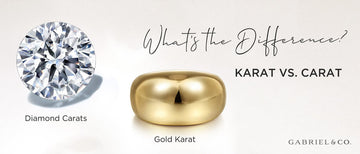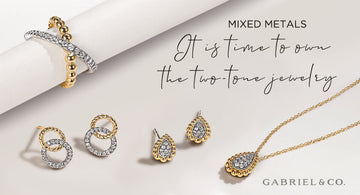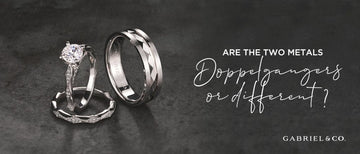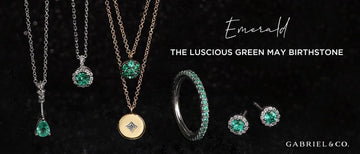


“What’s in a name?” Shakespeare very famously said this over four centuries ago. Plenty, it turns out! Romeoand Juliet may disagree, but look where it got them. We, however, know exactly where we stand with our names, spellings, and meanings. Especially when it comes to our favorite topic of interest, jewelry.
We can quite clearly distinguish between our homophones – carrots, carats, karats, and carets. Is your head spinning yet? Don’t worry; we’ll have you sorted in a jiffy. Let’s first eliminate carrots from our vocabulary for now. These orange root vegetables are better suited to be Peter Rabbit’s food than a measure of anything to do with jewelry! Forget about carets as well. This wedge-shaped mark is used by editors or proofreaders to mark an insertion. Unless that insertion is a few more zeroes to your bank account, you really shouldn’t (and probably don’t) care. That leaves us with carat and karat – two measurements that are absolutely vital to the business of buying and selling, owning and wearing jewelry. Makes all the reason for us to establish sound acquaintance with them, right?
Simply put, one is a measurement of purity, and the other is a weight measurement. One is associated with metal, and the other with precious or semi-precious stones. Confused? Let us enunciate better.
In simple terms, gold purity is called karat. When 24 out of 24 parts are gold, it is considered pure gold. This is what is referred to as 24kt gold. However, while it is highly valued and expensive, pure gold isn’t efficient for making jewelry. The reason? It is too soft. To increase its durability and strength, gold is often mixed with alloys. The quantity of these alloys is measured based on their relationship to 24 parts gold. For instance, 2 parts alloy and 22 parts gold would have a purity of 22kt gold. Similarly, 6 parts alloy and 18 parts gold would have a purity of 18k gold. The alloys vary depending on whether it is white gold, yellow gold, or rose gold. White gold uses nickel and zinc, rose gold uses copper, and yellow gold uses a mix of nickel, copper, silver, and zinc.


Though they sound similar, karat and carat are absolutely unrelated, at least in their meanings. Carat is a measurement of the weight of precious and semi-precious stones. It is most commonly associated with diamonds and has even been standardized to 200 milligrams for this stone. 1 carat equals 200 mg of diamond weight. However, other gemstones, from emeralds to sapphires and rubies, are also measured in this unit. Since nature has bestowed each gemstone with its own distinct attributes – density, weight, purity, and more, the size per carat tends to vary for each gemstone type. So, a diamond that weighs 1ct might be a very different size and have an unidentical appearance than a freshwater pearl that weighs the same!
Now, this is tricky. It is believed that both words come from the ancient Greek term keration for ‘carob seeds’ – hard to believe, right? But the explanation behind it makes sense. A long time ago, before the metric system (or any system for that matter!) was invented, people had to find other ingenious ways to ensure they weren’t getting cheated vis-à-vis jewelry weights and prices. Voila, carob seeds were the solution! They were used to measure the weight of gold and diamonds simply because they were uniform in size and weight and tended to be more accurate than anything else found in nature.
Both the words had quite a journey before they found their current established status in the jewelry nomenclature. We have pulled out a few snippets of their journey, from history, for you, which are quite interesting. During his reign in the Roman Empire, King Constantine 1 introduced a pure gold coin currency called Solidus to bring down inflation. Each carob bean-carat was equivalent to 1/24th of a gold solidus coin. So it became associated with its proportion of 24 parts, and that is how the metric 24 karats of gold came into existence.
On the other hand, the word carat, too, traversed many parts of the world. When it traveled to Arab, it came to be known as qirat, which translates to bean pod and means ‘weight of four grains.’ The word then came to be known as carratus in Latin, carato in Italian, and finally, the old French carat, which literally translates to ‘measure of gold’s finesse.’ Since then, the term has stuck, although it has been through several spelling changes worldwide. It was first spelled ‘karat’ in the early 1900s when the famed American writer, O Henry, used it in one of his stories. If the word was good enough for him, it’s good enough for all of us! And so the name stuck.
Karat is the correct usage for measuring gold purity in the United States of America. Carat is used only for gemstone weights. But then, as a famous quote goes, “We are separated by a common language.” In many parts of the world, such as the United Kingdom and Australia, carat is used for gold purity and gemstone weight alike. We suppose it’s alright if you look at the jewelry in context and know what you’re signing up for.

Simply because it’s important to ensure that you know what purity of gold to purchase. If your jewelry says 14K, 14 parts (or carats) are pure gold, and 10 parts are another metal. Don’t go around paying more for it than you should. Also, when you see the abbreviation K, you know it necessarily refers to purity. There is no confusion between k and ct – the latter being the abbreviation for the gemstone carat weight.
To ascertain your gold jewelry’s karat weight, you must take your jeweler’s word for it. This is why it is sacrosanct to visit a reputed brand and get a certified jewelry piece that is hallmarked with the exact purity. How do you ensure your jewelry’s legitimacy if you purchase it from a newly established or not a very well-known or coveted jeweler or, maybe, a non-certified dealer? By destroying it. No, we’re not joking. It is literally the only way. To reaffirm its authenticity, you have to heat the jewelry to temperatures of over 1000 centigrade and watch the gold and alloys separate. Unfortunately, this means you will only be left with clumps of metal. Another way is to dissolve your ring in a solution of acids. Even X-rays won’t help you out here. If your jeweler has used iron (or even plastic or scrap) inside your ring, it can’t get past your outer layer to assess this.
In comparison, diamond carats are far easier to measure. Pop it on the weighing scale, and you’re done.
To be fair, there is no one correct answer for this. The only thing we’re sure of is to avoid 24k or pure gold without alloys since it is too soft and pliable. That isn’t to say that you can’t pick up gold bars or coins that measure 24k. In some geographies like Asia, and Africa, where gold jewelry is considered a precious investment, 22k gold is preferred, but only as gold coins or bars, not as gold jewelry. While buying 18k or 14k gold jewelry, the presence of alloys makes it more durable, but you still have to be mindful of the quality and shell out according to that and not just superficial appearance1. 18k gold is emerging as our favorite – it hits the sweet spot between price, durability, and value. Having said that, for a few designs that need the metal carvings to be more robust and grip the heavy, precious stones more firmly, 14k gold is the ideal choice. Not only is it sturdy, but it is also versatile and slightly lesser priced.


This is one question that leaves us as flummoxed as you. There is no end to how many carats your diamond can be. It entirely depends on your budget and to what extent you are willing to indulge yourself in luxury. Decadence has no cost or price to it, especially when it is something as enthralling as jewelry! The diamond carat you purchase can range from a few cents to a score, or maybe, even more. Just the way our celebrities and people with high net worth like it – a case in point, the queen singer Beyoncé recently wore a diamond necklace featuring a whopping 128.54-carat yellow diamond. Blew our minds off! No, we are not giving your aspirations any far-fetched, delusional wings. Anything from a single carat to a few carats of diamonds in jewelry is wonderful, taking into consideration the scoring of the other 3 C’s as well – color, cut, and clarity.

Fast, convenient payment methods

On orders above $250

30 days from the purchase
Are you 18 years old or older?
Sorry, the content of this store can't be seen by a younger audience. Come back when you're older.
We will notify you on events like Low stock, Restock, Price drop or general reminders so that you don’t miss the deal



